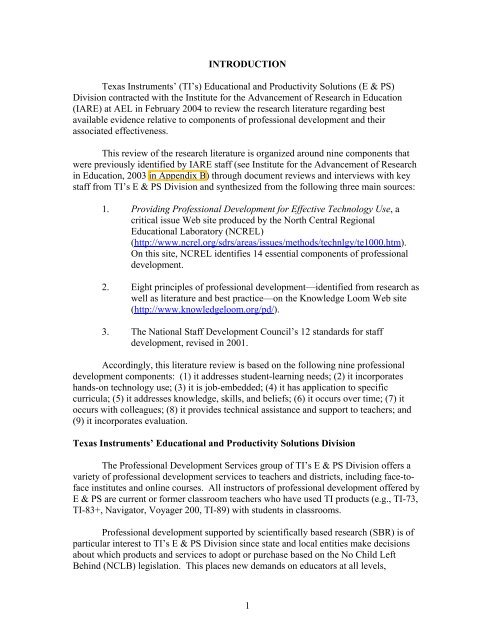Professional Development - Vol. IV, Part I
Professional Development - Vol. IV, Part I
Professional Development - Vol. IV, Part I
Create successful ePaper yourself
Turn your PDF publications into a flip-book with our unique Google optimized e-Paper software.
INTRODUCTION<br />
Texas Instruments’ (TI’s) Educational and Productivity Solutions (E & PS)<br />
Division contracted with the Institute for the Advancement of Research in Education<br />
(IARE) at AEL in February 2004 to review the research literature regarding best<br />
available evidence relative to components of professional development and their<br />
associated effectiveness.<br />
This review of the research literature is organized around nine components that<br />
were previously identified by IARE staff (see Institute for the Advancement of Research<br />
in Education, 2003 in Appendix B) through document reviews and interviews with key<br />
staff from TI’s E & PS Division and synthesized from the following three main sources:<br />
1. Providing <strong>Professional</strong> <strong>Development</strong> for Effective Technology Use, a<br />
critical issue Web site produced by the North Central Regional<br />
Educational Laboratory (NCREL)<br />
(http://www.ncrel.org/sdrs/areas/issues/methods/technlgy/te1000.htm).<br />
On this site, NCREL identifies 14 essential components of professional<br />
development.<br />
2. Eight principles of professional development—identified from research as<br />
well as literature and best practice—on the Knowledge Loom Web site<br />
(http://www.knowledgeloom.org/pd/).<br />
3. The National Staff <strong>Development</strong> Council’s 12 standards for staff<br />
development, revised in 2001.<br />
Accordingly, this literature review is based on the following nine professional<br />
development components: (1) it addresses student-learning needs; (2) it incorporates<br />
hands-on technology use; (3) it is job-embedded; (4) it has application to specific<br />
curricula; (5) it addresses knowledge, skills, and beliefs; (6) it occurs over time; (7) it<br />
occurs with colleagues; (8) it provides technical assistance and support to teachers; and<br />
(9) it incorporates evaluation.<br />
Texas Instruments’ Educational and Productivity Solutions Division<br />
The <strong>Professional</strong> <strong>Development</strong> Services group of TI’s E & PS Division offers a<br />
variety of professional development services to teachers and districts, including face-toface<br />
institutes and online courses. All instructors of professional development offered by<br />
E & PS are current or former classroom teachers who have used TI products (e.g., TI-73,<br />
TI-83+, Navigator, Voyager 200, TI-89) with students in classrooms.<br />
<strong>Professional</strong> development supported by scientifically based research (SBR) is of<br />
particular interest to TI’s E & PS Division since state and local entities make decisions<br />
about which products and services to adopt or purchase based on the No Child Left<br />
Behind (NCLB) legislation. This places new demands on educators at all levels,<br />
1

















